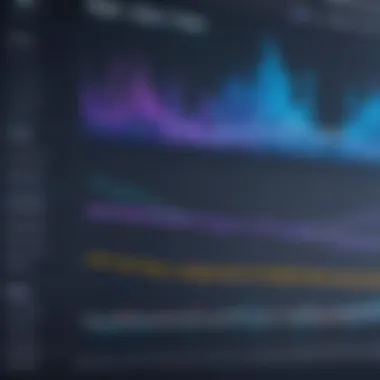Exploring Graph Visualization Tools for IT Professionals


Intro
In today's data-driven world, graph visualization tools have become essential for IT professionals and tech enthusiasts alike. These tools enable users to represent complex datasets in an easily digestible format, allowing for enhanced analysis and decision-making. This overview focuses on the characteristics and functionalities of leading graph visualization tools, their significance, and various applications. The aim is to guide readers towards making informed choices and leveraging these tools effectively in their work.
Understanding the intricacies of graph visualization can greatly enhance productivity. Users must grasp the relevant performance metrics, usability factors, and integration capabilities that different tools offer. By navigating through this guide, readers will gain valuable insights into the most effective practices for utilizing these specialized tools.
With the right knowledge at hand, IT professionals can make better use of graph visualization tools, improving their approach to data analysis and representation. This article will dissect key elements, enriching the understanding of what makes these tools standout in today’s technology landscape.
Performance Metrics
Graph visualization tools vary in performance. Understanding their metrics is vital for selecting the appropriate tool for specific needs. Here are two critical aspects discussed:
Benchmarking results
Benchmarking evaluates how well a graph visualization tool performs against its competitors. Key performance indicators include:
- Data processing speed: Speed is crucial; users need tools that handle large datasets efficiently.
- Rendering time: The time required to display visualizations affects user experience.
Speed and responsiveness
A tool’s speed reflects its responsiveness to user commands and its ability to handle complex queries. High responsiveness typically translates to better user satisfaction. When evaluating tools, it's important to consider:
- Interactive features: Tools that allow for real-time interaction foster deeper insights.
- Scalability: As datasets grow, a visualization tool should maintain performance without significant lag.
Usability and User Experience
User satisfaction hinges on the usability of the graph visualization tool. Two important areas warrant attention:
Ease of installation and setup
The initial setup process can influence the decision to employ a specific tool. Consider the following points:
- Guided installation process: Step-by-step assistance can prevent common pitfalls.
- Compatibility: Tools that integrate smoothly with existing frameworks offer a better user experience.
Interface design and navigation
An intuitive interface enhances usability. Users should evaluate:
- Visual layout: A clear, uncluttered design aids in easier navigation.
- Accessibility of features: Frequently used tools should be readily available, minimizing the time spent searching.
Effective data analysis requires more than just powerful tools; user experience plays a significant role. Tools that prioritize usability can enhance productivity and foster a more engaging analytical environment.
Preface to Graph Visualization
Graph visualization tools are essential in today’s data-centric world. They enable users to see complex relationships clearly, thus enhancing understanding. These tools provide vital perspectives when analyzing large datasets. Understanding graph visualization is not just about using software; it also involves recognizing the context and purpose behind each visualization.
Definition and Importance
Graph visualization refers to the graphical representation of data in a format that emphasizes relationships. Its importance lies in its ability to translate complex data into a visual format. This makes it much easier to spot trends, patterns, and anomalies. For IT professionals, effectively using graph visualization can lead to better insights and more informed decisions. One needs to evaluate various tools to find one that aligns closely with specific needs and goals.
Applications in Various Fields
Graph visualization tools find applications across multiple domains. Their versatility allows adaptation to various fields. Here, we will consider specific applications in data science, business intelligence, and network analysis.
Data Science
In data science, graph visualization serves as a crucial method for exploration and presentation of data. It helps in uncovering insights hidden within datasets. A key characteristic of this application is its capability to manage and interpret vast amounts of data. Graphs and charts facilitate effective communication of statistical findings. However, the challenge lies in ensuring that visualizations remain clear and not overly complex, which can mislead conclusions.
Business Intelligence


Within business intelligence, graph visualization plays a transformative role in analytic reporting. It allows organizations to make sense of their performance metrics. The ability to present data visually helps stakeholders grasp the nuances of business operations quickly. Its ease of use is a significant advantage, often resulting in faster decision-making. A potential disadvantage is the risk of oversimplifying data, leading to important details getting overlooked.
Network Analysis
Network analysis utilizes graph visualization to evaluate connections among entities. This method is particularly useful for depicting social networks, communication paths, or any interconnected systems. A key characteristic of network analysis is its emphasis on relationship dynamics. It offers valuable insights into the strength and type of links between network nodes. While powerful, the visualization can become cluttered if the network is too large, obscuring critical information.
An effective graph visualization tool should adapt to the specific needs and characteristics of the data being analyzed, ensuring clarity and insight.
Types of Graph Visualization Tools
Graph visualization tools are essential for transforming complex data into comprehensible formats. Understanding the types of tools available empowers IT professionals to choose the right solution for their specific needs. This section highlights the significant aspects of graph visualization tools, focusing on two key categories: static and interactive tools, as well as customizable visualization options. Knowing which type best suits a situation can enhance data interpretation and decision-making.
Static vs. Interactive Tools
Static tools provide a fixed representation of data. They are often used when the data set is stable and does not change frequently. Static graphs can be generated quickly and efficiently, making them suitable for reports, presentations, or academic publications. Formatting options can be adjusted before exporting the final visual. However, users cannot manipulate these graphics once created.
In contrast, interactive tools allow users to engage dynamically with their data. Users can click, zoom, filter, and explore the data sets in real-time. This flexibility is crucial for large, complex datasets where insights are buried deep within the details. For instance, tools like D3.js or Plotly enable users to gain insights by iteratively exploring the visualizations.
Here’s a summary of the benefits:
- Static Tools:
- Interactive Tools:
- Quick to produce
- Stable representation
- Simple to use for presentations
- Dynamic engagement with data
- In-depth exploration
- Better suited for large datasets
Customizable Visualization Tools
Customizable visualization tools enable users to tailor their graphs based on specific requirements. This can include altering colors, shapes, and layouts to better reflect the data story. Tools like Tableau and Gephi stand out for their flexibility, allowing users to create visualizations that resonate more profoundly with their audience.
Customization offers the chance to blend various data types into a single representation. Users can integrate multiple datasets, showcasing relationships that static tools may overlook. Furthermore, custom settings can enhance the interpretability of the visuals by aligning them closer to the user’s objectives and preferred aesthetics.
"Customization in graph visualization not only enhances the clarity but also engages the audience effectively by presenting relevant data in an intuitive manner."
Key points to consider when selecting customizable tools include:
- Compatibility with existing data structures
- Availability of user-friendly interfaces
- Support for diverse visualization formats
Key Features of Graph Visualization Tools
The effectiveness of graph visualization tools lies significantly in their design and functional features. These tools serve as a bridge between complex datasets and comprehensible insights. Users, particularly IT professionals and data analysts, rely on specific features to enhance their data analysis capabilities. Understanding these key features is crucial for anyone looking to leverage graph visualization effectively.
User Interface Design
User interface design plays a vital role in the usability of graph visualization tools. A well-designed interface allows users to navigate the tool effortlessly and access essential functionalities without difficulty. This is especially important in high-stakes environments where time is critical. Many tools provide a variety of visualization options, from bar graphs to network diagrams. The choice of visualization should be intuitive and easy to manipulate. Key elements such as drag-and-drop functionalities, customizable dashboards, and responsive layouts contribute to an enhanced user experience.
Moreover, a clean layout minimizes distractions. Users should be able to focus on data interpretation rather than struggling to understand how to use the software. This aspect often differs from tool to tool and requires careful consideration when choosing a platform.
Data Import and Export Capabilities
The ability to import and export data from various sources is another critical feature in graph visualization tools. Effective data management allows users to work with existing databases and datasets efficiently. Many tools support formats like CSV, Excel, and even JSON. This versatility is essential because organizations often deal with diverse data sources.
Export capabilities matter as well. Users need to generate reports, share visualizations, or save outputs in various formats. Whether it's exporting to PDF or embedding visualizations in presentations, the flexibility to manage outputs will enhance communication of insights.
Considerations for effective data handling include:
- Compatibility with existing data systems
- Ease of access for both import and export
- Support for large datasets
Integration with Other Software
Integration capabilities with other software tools greatly enrich the functionality of graph visualization tools. Users frequently combine different software solutions to achieve comprehensive data analysis. Tools that can seamlessly integrate with platforms like Tableau, Excel, and database management systems enhance productivity and workflow.


For example, if a graph visualization tool can pull real-time data from an SQL database, users can work with the most updated information. This integration not only saves time but also reduces the chances of using outdated data.
Furthermore, the ability to connect with business intelligence tools can amplify analytical capabilities. Tools offering APIs allow developers to create custom integrations, making them highly flexible for specific user needs.
"Integration is not just about connecting. It's about creating a cohesive ecosystem where information flows unimpeded, enabling data-driven decisions."
Evaluating Graph Visualization Tools
Evaluating graph visualization tools is crucial for IT professionals and tech enthusiasts who aim to select the best software for their data analysis needs. The effectiveness of these tools determines how well complex datasets can be understood and communicated. A thorough evaluation involves looking closely at key performance metrics such as speed and scalability, along with user feedback and community ratings. These elements not only enhance the decision-making process but also ensure that the chosen tool aligns with specific project requirements.
Performance Metrics
Speed of Visualization
Speed of visualization refers to how quickly a tool can render data into a graphical format. This characteristic is vital because a faster pace in generating visuals allows users to analyze data more effectively and make timely decisions. In our discussion, we see that tools with high-speed visualization capabilities often leverage optimized algorithms to present massive datasets efficiently.
One unique feature here is the ability to handle real-time data updates, offering instant visual feedback which is favorable in fast-paced environments. However, there may be drawbacks, such as potential limitations in rendering complex graphs, which might slightly lag under certain conditions.
Scalability
Scalability is the ability of a graph visualization tool to manage increasing amounts of data without losing performance quality. This aspect is essential for organizations that anticipate growth or fluctuations in data volume. Tools that excel in scalability can dynamically adapt and maintain usability, supporting large datasets while ensuring quick rendering times. A notable characteristic is their capacity to integrate with databases that can also grow, such as SQL or NoSQL. Although many tools advertise scalability, testing in real-world scenarios is necessary to confirm that they meet the required standards without significant drop in performance.
User Feedback and Community Ratings
User feedback and community ratings serve as a valuable resource when evaluating graph visualization tools. This input reflects real-world experiences and can guide potential users toward tools that suit their needs. It's advisable to consider factors such as the responsiveness of the developer to user suggestions and the overall satisfaction level of the community.
"User experience can highlight features or limitations that are not always apparent through standard reviews."
By reviewing comments and ratings on platforms like Reddit or dedicated tech forums, users can gather insights about a tool's performance, reliability, and ease of use. Additionally, trends in feedback can indicate which tools are evolving to meet user needs, which is an important consideration in choosing a fitting solution for data visualization.
Leading Graph Visualization Tools
Graph visualization tools play a crucial role in the interpretation of complex datasets. They are essential for IT professionals and tech enthusiasts alike, serving not only as a medium to present data graphically but also as instruments to uncover insights hidden in data structures. Choosing the right tool can drastically improve efficiency and understanding. Specific elements that define these tools include their usability, feature sets, integration capabilities, and performance metrics. In this section, we will explore three leading graph visualization tools, detailing their features and practical applications.
Tool One: Overview and Features
One notable tool in the realm of graph visualization is Neo4j. This graph database management system is particularly effective for handling large datasets featuring complex relationships. Neo4j’s flexibility allows users to model real-world systems and visualize data connections effectively. One of its main features is the Cypher query language, which simplifies data retrieval and manipulation. Additionally, Neo4j provides graph algorithms and the ability to perform analytics directly in the database. The tool integrates with various programming languages and platforms, enhancing its accessibility for diverse user bases.
Tool Two: Overview and Features
Another prominent tool is Graphistry. This tool specializes in visualizing large-scale graphs efficiently. What sets Graphistry apart is its GPU acceleration, which allows for rapid rendering of graphs that might otherwise be too complex for conventional tools. Users can upload data sources directly and create interactive visualizations with minimal setup. Furthermore, Graphistry supports collaboration, allowing multiple users to explore the same visualizations in real time. Its integration with existing business intelligence platforms makes it a useful asset for data-driven organizations.
Tool Three: Overview and Features
A third key player is Gephi. This open-source software excels in the exploration and manipulation of networks and graphs. Gephi’s real-time visualization capabilities allow users to see changes as they manipulate data, offering instant feedback that aids in analysis. The tool includes a variety of layout algorithms, providing flexibility in how information is represented. Gephi also supports extensive plugins, enabling users to extend functionality as needed and customize visualizations according to specific requirements. Its straightforward interface is suitable for both beginners and seasoned professionals.
"Effective graph visualization is not just about making the data look appealing; it's about making it understandable and actionable."
Each of these tools highlights unique strengths and features, catering to various needs within the field of graph visualization. Selecting the right tool depends on project requirements, data complexity, and user proficiency.
Emerging Trends in Graph Visualization
In the rapidly evolving landscape of data analysis and visualization, staying abreast of emerging trends in graph visualization is crucial for IT professionals and tech enthusiasts. This section focuses on two significant trends: the integration of artificial intelligence and the advent of real-time data visualization. Both trends promise to enhance the usability and effectiveness of graph visualization tools, providing users with more powerful means to interpret complex datasets.
Artificial Intelligence Integration
The integration of artificial intelligence (AI) in graph visualization tools is reshaping how data is analyzed and presented. By leveraging AI algorithms, these tools can process vast amounts of data with speed and accuracy. AI can enhance various aspects of graph visualization, including:
- Automated Data Classification: AI can automatically categorize data points, helping users easily identify patterns and anomalies within their visualizations.
- Predictive Analytics: Using machine learning, AI-driven tools can forecast trends and potential outcomes, providing deeper insights into data behaviors.
- User Personalization: AI can tailor visual presentations to individual user preferences, improving engagement and comprehension.
However, the integration of AI also brings challenges. There is a need for transparency in how AI algorithms function to build trust among users. Additionally, with increasing reliance on AI, there must be a careful balance between automation and human oversight.


Real-Time Data Visualization
Real-time data visualization takes data presentation a step further by allowing users to monitor and interact with live data feeds. This capability is critical in various sectors, such as finance, telecommunications, and social media, where timely information is vital for decision-making.
Key advantages of real-time data visualization include:
- Immediate Insights: Users can react to data changes as they happen, enabling quicker responses to trends or issues.
- Enhanced Collaboration: Teams can analyze data together in real-time, fostering dynamic discussions based on up-to-date information.
- Improved Monitoring: For sectors like IT, real-time visualization aids in system monitoring, alerting teams to issues before they escalate.
The main consideration with real-time data visualization is the infrastructure it requires. Organizations need robust systems to handle real-time data streaming effectively. Ensuring data accuracy and handling latency issues will also be essential.
"As technology advances, the ability to visualize data in real-time transforms how decisions are made, specifically within fast-paced environments."
Best Practices for Using Graph Visualization Tools
When utilizing graph visualization tools, following best practices is essential for achieving effective data analysis and representation. The selection, structuring, and iterative improvement of visualizations play significant roles. These practices ensure that the visualizations created are not only informative but also user-friendly. By adhering to these guidelines, IT professionals can maximize the potential of their tools and enhance the communication of complex datasets.
Selecting the Right Tool for Your Needs
Choosing the appropriate graph visualization tool begins with understanding the specific requirements of your project. Each tool in the market offers various features and functionalities, which can be overwhelming. Hence, it is vital to consider some factors before making a choice:
- Type of Data: Identify the kind of data you are working with. Some tools perform better with specific data types, like networks, hierarchical data, or time series.
- Integration: Assess how well the tool integrates with your existing software environments. Tools like Tableau or Microsoft Power BI offer strong compatibility with numerous data sources.
- User Interface: Consider the ease of use. A user-friendly interface can reduce the learning curve significantly.
- Cost: Think about your budget. While some tools are free, others can incur licensing fees.
This comprehensive evaluation ensures that you select a tool that aligns with project goals, thus preventing potential issues down the line.
Effective Data Structuring
Once a suitable tool has been selected, structuring your data is the next critical element. Proper data organization not only enhances clarity but also affects how insights are derived. Effective structuring involves the following:
- Consistency: Data should be consistent across various formats and sources. This helps in reducing confusion and errors during visualization.
- Normalization: Normalize your data to ensure comparability. This provides a clear basis for data interpretation.
- Documentation: Maintain thorough documentation regarding the data attributes and sources. Clear documentation fosters better communication among team members and stakeholders.
The better structured your data is, the more effectively it can be visualized and interpreted.
Iterative Improvement of Visualizations
Creating a visualization is just the beginning. The process of iterative improvement is essential to refine the accuracy and usefulness of the visual representation. The following steps can aid in this iterative cycle:
- Solicit Feedback: Gathering insights from peers or end-users helps identify potential areas for improvement. This feedback can dramatically enhance the quality of visualization.
- Analyze User Interaction: Understanding how users interact with the visualization can provide critical information. Tools may offer analytics that track user behavior.
- Update Regularly: As new data becomes available, it is imperative to update your visualizations. Adjusting visualizations to reflect the most recent data maintains their relevance.
By employing a cycle of continuous enhancement, the quality of output improves, leading to better data-driven decisions.
"Proper selection and structuring of visualization tools combat redundancy and inefficiency in data analysis, leading to enhanced accuracy and clarity."
Incorporating these best practices ensures that graph visualization tools are utilized to their fullest potential. This focus on practical aspects allows IT professionals to convey complex insights more clearly, ultimately benefiting their projects and organizations.
Epilogue
The conclusion of this article serves as a critical point of synthesis, bringing together the diverse insights offered throughout the preceding sections. This part not only encapsulates the essential information on graph visualization tools but also reinforces their significance in today’s data-driven environment. Understanding these tools enables IT professionals to leverage complex datasets effectively, making data analysis and representation more impactful.
One key element discussed is the versatility of various graph visualization tools available on the market. Their distinctive features allow users to address specific challenges related to data interpretation. This selection process requires a thorough understanding of functionality and usability. A well-informed choice leads to better insights and more informed decision-making.
The benefits of utilizing graph visualization tools extend to improved collaboration. As teams share visual data, they can communicate insights more clearly and efficiently, reducing misinterpretation and fostering a more informed workplace.
While evaluating the future directions of graph visualization tools, it becomes apparent that the importance of adaptation cannot be understated. With emerging technologies such as artificial intelligence and real-time data visualization, the landscape is continuously evolving. IT professionals must stay abreast of these developments to maximize the tools’ potential.
Summary of Key Insights
- Definition and Importance - Graph visualization tools transform complex data sets into manageable visual formats, enhancing comprehension.
- Applications - These tools are pivotal across sectors, including data science, business intelligence, and network analysis.
- Key Features - Important attributes include user interface design, data import/export capabilities, and software integration.
- Emerging Trends - Innovations like AI integration and real-time visualization are shaping the future of data interpretation.
- Best Practices - Selecting appropriate tools and structuring data effectively promotes better analysis outcomes.
In essence, a well-rounded understanding of these insights equips professionals with the necessary knowledge to navigate the intricacies of data visualization effectively.
The Future of Graph Visualization Tools
The future of graph visualization tools appears promising, characterized by transformative developments that are reshaping the user experience. Innovations like artificial intelligence offer the potential for more sophisticated analytics, allowing for deeper insights extracted directly from data. Real-time data processing can also be expected to become a standard feature, catering to the increasing demand for instantaneous information access.
As we look to the future, the integration of advanced algorithms in visualization tools can enhance not only how data is displayed but also how users interact with that data. Improved usability is vital, as it fosters increased adoption among professionals less familiar with advanced techniques.
Moreover, we can anticipate a greater emphasis on customization, enabling users to tailor visual outputs to their unique requirements. This will make graph visualization tools more adaptable to specific industries and use cases, ensuring relevance across various domains.



